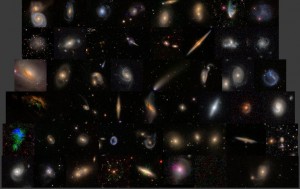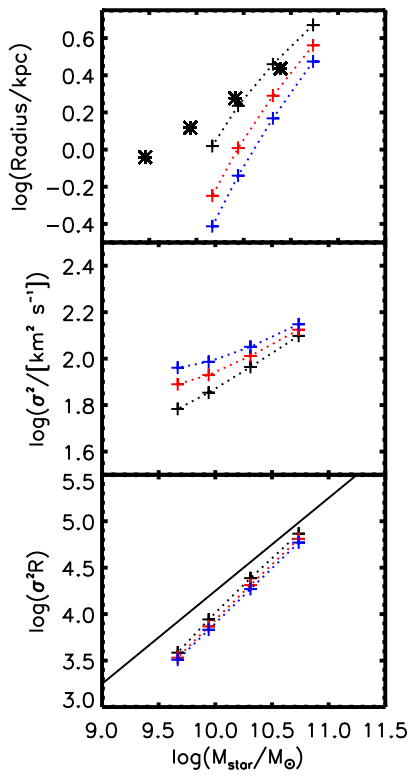- Title: The rise and fall of stellar discs across the peak of cosmic star formation history: mergers versus smooth accretion
- Authors: Charlotte Welker, Yohan Dubois, Julien Devriendt, et al.
- First Author’s Institution: Institut d’Astrophysique de Paris
- Paper Status: Submitted to Monthly Notices of the Royal Astronomical Society

Fig 1 – Galaxies come in countless shapes, sizes, and colors. The goal of the study of “Galaxy Evolution” is to understand what causes this brilliant diversity. Images from Galaxy Zoo.
There is a wide variety of galaxies throughout our universe — see the figure to the right. Some galaxies are very large, with a huge number of stars in them. Others could have just as many stars, but are crowded together in a much smaller space. They also may vary in their morphology: whether they are flat disks (like the Milky Way) or round spheroids. A major goal in the study of galaxies is to understand where this galaxy diversity comes from: have they always been so different, or do these differences develop as they evolve?
Because galaxies change over many billions of years (a billion years is often abbreviated a Gyr), it is quite challenging for astronomers to infer how they evolve from observations alone. To study how galaxies may grow, the authors of today’s paper used a cosmological simulation (similar to the one discussed in this Astrobite). The “Horizon-AGN” simulation modeled a miniature universe filled with over 150,000 galaxies, observing how they are created and interact with one another over more than four billion years. In particular, they studied the evolution of galaxies between 12 and 8 billion years ago, when observations tell us galaxies were undergoing their largest growth spurts.
The authors consider two particular mechanisms through which galaxies change. Galaxies will slowly add loose material — such as gas and stray stars — which is captured by gravity: this is called “smooth accretion“. Galaxies will also occasionally collide and “merge” with their neighbors: these are “major mergers” if both galaxies are around the same size and “minor mergers” if one is much smaller than the other. This paper reports the group’s findings on how smooth accretion and mergers affect three important aspects of galaxy formation:
- How do galaxies gain new stars (increase their mass)?
- How do they grow (or shrink) in physical size?
- How do their morphologies change?
The researchers first had to create a merger tree for the simulated galaxies. At several dozen snapshots during the run, they recorded a list of all galaxies currently in the simulation. Each galaxy in the list is then connected to its progenitor galaxies in the previous snapshot. If a galaxy evolved through mergers, it may have several progenitors. One which only grew by smooth accretion would have only one progenitor, and a newly formed galaxy would have none. This process generates a family history, where each final galaxy has information on how much it grew by smooth accretion, by minor mergers, and by major mergers.

Figure 2 – The growth of galactic radii (y-axis), relative to the percentage change in galaxy mass (x-axis). Adding a given amount of mass via smooth accretion (red/green) causes very little change in radius. Instead, adding that much mass through a merger (blue) causes the radius to increase dramatically. Fig. 6 from Welker et al. 2015
The authors found that mergers and smooth accretion were each responsible for about 50% of the growth in the mass of galaxies. Yet the effects on their radial sizes were quite different, as shown in the figure to the left. When galaxies grew via smooth accretion, their radii changed only slightly. Yet a merger which added the same amount of mass usually resulted in a much more dramatic size increase.
Most importantly of all, the mechanism for adding material also affected the galactic morphology. Galaxies which underwent a major merger (or many minor mergers) became more spherical. If a galaxy already had formed a disk, it was disrupted by the violent process or merging. On the other hand, galaxies which accreted smoothly gradually became more disk-shaped. Gas is mostly pulled along a particular axis, causing the galaxy to spin up and form a disk. Even initially spheroidal galaxies became more disk-like if they only grew by smooth accretion.
With the power of these cosmological simulations, astronomers are able to trace the evolution of galaxies in ways that cannot be accomplished with observations alone. They suggest that the variety of galaxy morphologies and sizes can be connected to their history of accretion and mergers. Spiral galaxies have likely undergone fewer significant mergers than their spheroidal counterparts. The idea that elliptical galaxies are formed from major mergers also agrees with the longstanding theory of “hierarchical galaxy formation” (see this Astrobite).
Cosmological simulations certainly do not hold all the answers — many approximations are made in order to simplify the calculations. For instance, only a few thousand particles are used to model a “galaxy” that would have billions of stars in reality. Yet these simulations, rough though they may be, are a powerful tool to validate galaxy evolution models, in conjunction with deep observations of these galaxies, as viewed from billions of light years away.





Cosmological simulations are getting so impressive! It’s pretty cool that we can read off the merger history of a galaxy from just its morphology.
I agree, cosmological simulations are making a lot of great progress. That said, there’s clearly still some subtleties in the morphology-history relation, as the authors here divided up ALL elements of the history into these two distinct classes.
How much stock do we put in the outcomes of these simulations? As you mention, there are obviously a lot of approximations/assumptions being made, so to what degree do their outcomes directly influence new theories/research?
How much scientists trust these outcomes varies from person to person, but almost everyone must rely on their inferences to some degree. One way you can test these assumptions is: a) run a new simulation, with different assumptions (say, larger AGN feedback, lower SN feedback). b) compare the results of the new and old simulation to observations, see which look better. In addition to getting better simulations, you may be able to infer new information about what mechanisms are most important in making the universe the way it is.
Interesting post! If elliptical galaxies tend to have undergone mergers/collisions in the past, does the abundance of elliptical galaxies imply that collisions are relatively frequent?
That’s a very solid inference. In particular, this speaks to the “density-morphology” relation: crowded clusters of galaxies have many more Ellipticals, while the less-dense “field” is mostly filled with spirals. Since collisions are more likely in a dense cluster environment, the prediction made in this paper could explain the relation between environment and morphology.
Is it possible with these models to determine how many mergers occurred in a galaxy or is it just able to state if any had occurred?
Unfortunately, that’s very difficult to do on an individual basis; these authors draw their conclusions based off of overall statistical trends of many thousands of galaxies. A better way to investigate the merger history on an individual basis is to study the “Stellar Halo” (keep an eye out for my next post!)
http://www.eso.org/sci/meetings/2015/StellarHalos2015/rationale.html
Could it be that mergers result in more dramatic size increases because the galactic elements (nebulae/GMCs/stars etc) are trying to find a way to reach a sort of dynamic equilibrium after such a violent process?
That’s a great interpretation of what’s most likely happening.
How does the increase in frequency of mergers in spiral galaxies affect their lifespan?
Very nice post! How often do galaxies go through a merging process?
That can vary widely depending on the environment the galaxy is in. Galaxies in groups/clusters will have interactions far more often than in the field. The Milky Way and Andromeda are set to have a (major) merger in a few billion years
Is it just a coincidence that both mergers and smooth accretion each account for half of galaxy growth or is there some physical mechanism that causes this equal divide?
I don’t think that’s well understood by the authors. It generally means that both mechanisms are similarly important, although the 50-50 split may be more of a coincidence
Do we have an estimate for how common these mergers are?
This article discusses smooth accretion and major mergers, but it seems like there is still a lot we don’t know about the fundamental beginnings of galaxy formation. Surely there are other forms of accretion before smooth accretion and major mergers?
Galaxy formation is certainly a complicated process, and this paper is primarily dealing with the evolution of galaxies after they’ve first formed. The initial formation of galaxies is mostly driven by gravitational collapse, somewhat similar to smooth accretion, where mass (both dark matter and gas) is pulled together into large clumps that form the galaxies.
Is the primary reason we use so few particles in these galaxy formation simulations limited computational power or is there another reason for it?
Yes, it all comes down to how much memory the simulation can hold at once. Having to track the information for a trillion particles is much more difficult than for a billion, and so on.